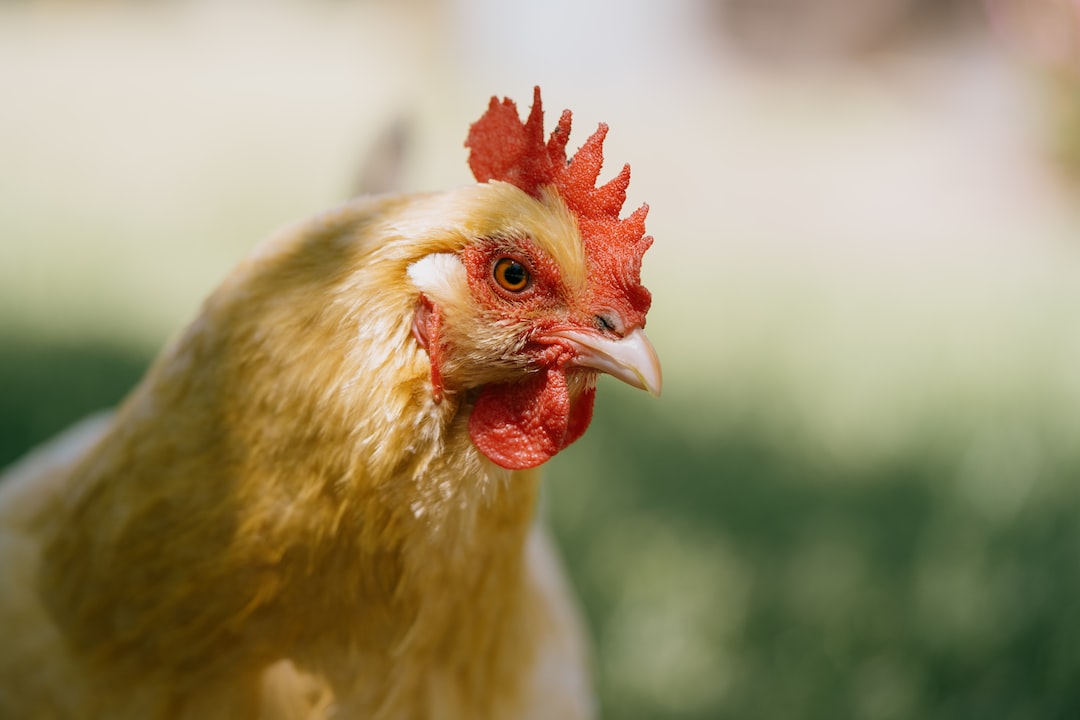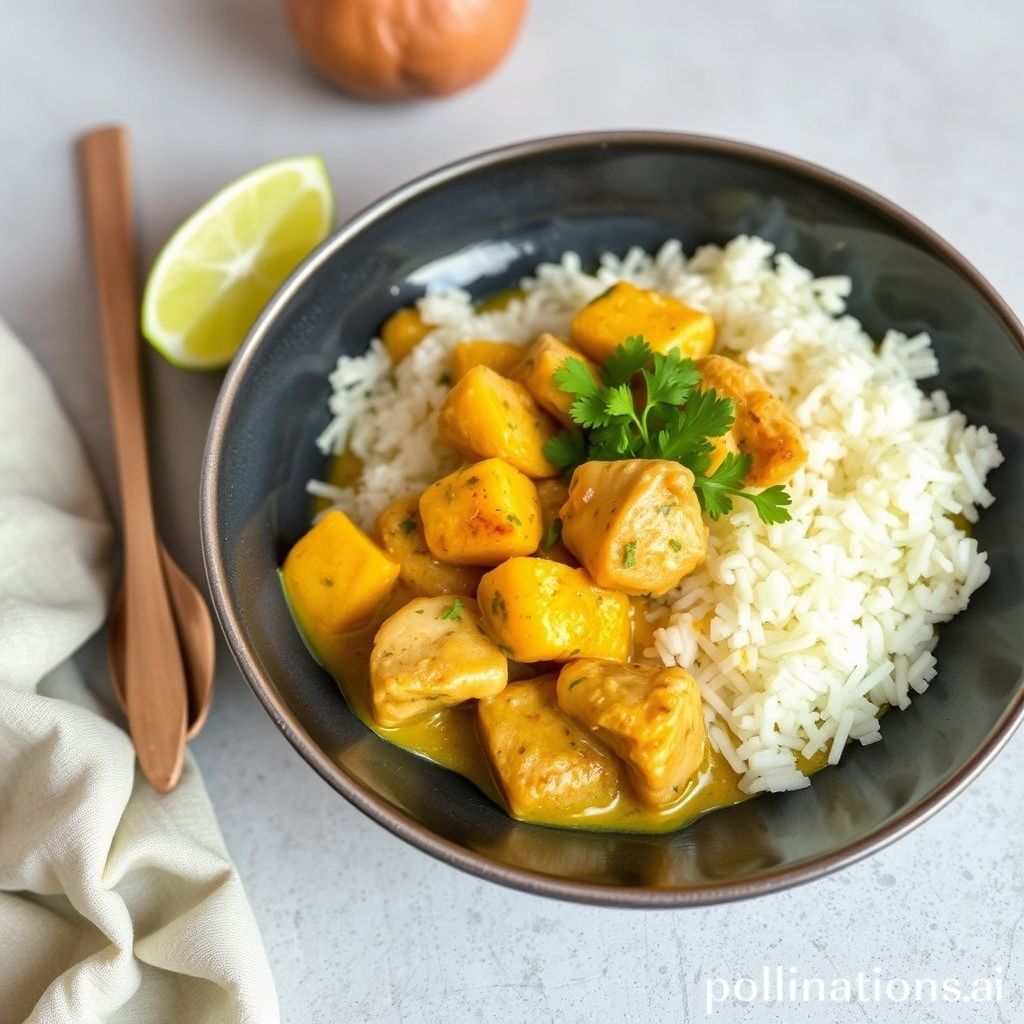Table of Contents
- Introduction
- Ingredients for Coconut Curry Chicken
- Step 1: Prepare the chicken breast
- Step 2: Make the coconut curry sauce
- Step 3: Cook the chicken in the sauce
- Step 4: Add vegetables and simmer
- Step 5: Serve with rice
- Step 6: Garnish with fresh cilantro
- Step 7: Tips and variations
- Conclusion
- Frequently Asked Questions
Introduction
Get ready to tantalize your taste buds with the delightful flavors of Coconut Curry Chicken! This mouthwatering dish combines succulent chicken, aromatic spices, creamy coconut milk, and vibrant vegetables, creating a culinary masterpiece that will transport you to exotic destinations.
Whether you’re a fan of spicy cuisine or simply enjoy indulging in rich and creamy dishes, this Coconut Curry Chicken recipe is a must-try. The perfect balance of sweet, savory, and spicy flavors will captivate your senses and leave you craving for more.
With the unique combination of coconut milk and curry spices, this dish offers a tropical twist to your usual chicken recipes. It’s a versatile dish that can be customized to suit your preferences and dietary needs, making it an ideal choice for both weeknight dinners and special occasions.
So, gather your ingredients, sharpen your knives, and let’s embark on a culinary adventure as we explore the tantalizing flavors and aromas of Coconut Curry Chicken!
Ingredients for Coconut Curry Chicken
Coconut Curry Chicken is a delicious and flavorful dish that combines the richness of coconut milk with aromatic spices to create a satisfying meal. The key ingredients for making Coconut Curry Chicken include:
– Chicken: Choose boneless, skinless chicken breasts or thighs for this recipe. They can be cut into bite-sized pieces for easier cooking and eating.
– Coconut Milk: This is the base of the curry sauce and provides a creamy and slightly sweet flavor. Use full-fat coconut milk for a richer taste.
– Curry Paste: A good quality curry paste adds depth and complexity to the dish. Red or green curry paste works well for Coconut Curry Chicken.
– Vegetables: Add vegetables like bell peppers, onions, and carrots to enhance the flavor and texture of the dish.
– Spices: Common spices used in Coconut Curry Chicken include garlic, ginger, turmeric, cumin, and coriander. These spices add warmth and aromatic flavors to the dish.
– Fresh Herbs: Garnish the Coconut Curry Chicken with fresh cilantro or Thai basil leaves for a burst of freshness.
Step 1: Prepare the chicken breast
To prepare the chicken breast for coconut curry chicken, start by rinsing the chicken breast under cold water to remove any impurities. Pat it dry using paper towels.
Next, place the chicken breast on a cutting board and use a sharp knife to carefully trim off any excess fat or skin. It’s important to remove any tough or undesirable parts to ensure a tender and flavorful chicken.
After trimming, you can cut the chicken breast into bite-sized pieces or leave it whole, depending on your preference. Cutting the chicken into smaller pieces will allow it to cook faster and absorb more of the delicious curry flavors.
Once the chicken breast is prepared, season it generously with salt and pepper on both sides. This will enhance the natural flavors of the chicken and add a touch of seasoning to each bite.
Your chicken breast is now ready to be cooked in the coconut curry sauce, bringing together the perfect blend of flavors in this delightful dish.
Step 2: Make the coconut curry sauce
To make the coconut curry sauce for your delicious coconut curry chicken, you will need a few key ingredients. Start by heating some oil in a large saucepan over medium heat. Add finely chopped onion, minced garlic, and grated ginger to the pan, and sauté until they are fragrant and softened.
Next, it’s time to add the spices. Sprinkle in some curry powder, turmeric, cumin, and coriander, and stir well to combine. Let the spices cook for a minute or two to release their flavors.
Now, it’s time to add the star of the show – the coconut milk. Pour in a can of full-fat coconut milk and stir it into the spice mixture. Bring the sauce to a gentle simmer and let it cook for about 10 minutes to allow the flavors to meld together.
For extra depth of flavor, you can also add some chicken or vegetable stock to the sauce. Simply pour it in, stir, and let it simmer for a few more minutes.
That’s it! Your coconut curry sauce is ready to be combined with cooked chicken and vegetables to create a mouthwatering coconut curry chicken dish. Get ready to enjoy a burst of exotic flavors in every bite!
Step 3: Cook the chicken in the sauce
After marinating the chicken in the coconut curry sauce, it’s time to cook the chicken in the sauce. Heat a large skillet or frying pan over medium heat and add a tablespoon of cooking oil. Once the oil is hot, carefully add the marinated chicken pieces to the pan, making sure not to overcrowd the pan.
Cook the chicken for about 5-7 minutes on each side, or until it is fully cooked and browned. The cooking time may vary depending on the size and thickness of your chicken pieces. Make sure to turn the chicken pieces occasionally to ensure even cooking.
As the chicken cooks, the flavors from the coconut curry sauce will infuse into the meat, creating a delicious and aromatic dish. Once the chicken is fully cooked, remove it from the pan and set it aside.
Now that the chicken is cooked, you can proceed to the next step and serve the coconut curry chicken alongside steamed rice or naan bread. The creamy, flavorful sauce combined with tender chicken makes for a satisfying and tasty meal.
Step 4: Add vegetables and simmer
Step 4: Add vegetables and simmer
After the chicken has cooked through, it’s time to add the vegetables to the coconut curry mixture. You can use a variety of vegetables, such as bell peppers, carrots, and snow peas, to add color and texture to the dish.
Chop the vegetables into bite-sized pieces and add them to the pot. Stir well to coat the vegetables with the flavorful sauce.
Reduce the heat to low and cover the pot. Let the curry simmer for about 10-15 minutes, or until the vegetables are tender. This slow cooking allows the flavors to meld together and creates a delicious and aromatic curry.
Do not overcook the vegetables as they should still have a slight crunch. This adds a nice contrast to the creamy curry sauce.
Once the vegetables are cooked to your liking, remove the pot from the heat. Your coconut curry chicken is now ready to be served!
Step 5: Serve with rice
Step 5: Serve with rice
Once the coconut curry chicken is cooked to perfection, it’s time to serve it with some fluffy rice. The combination of the creamy curry sauce and the fragrant rice is simply irresistible. Here’s how you can serve it:
1. Prepare the rice: Cook your rice according to the package instructions. You can use white rice, brown rice, or even fragrant basmati rice to complement the flavors of the curry.
2. Plate the chicken and curry: Place a generous portion of the coconut curry chicken on a plate or in a shallow bowl. Make sure to include plenty of the flavorful sauce.
3. Add the rice: Spoon a serving of cooked rice next to the chicken. You can shape the rice into a mound or use a ring mold for a more elegant presentation.
4. Garnish and enjoy: Finish off the dish with some fresh herbs like cilantro or basil for a pop of color and freshness. Serve the coconut curry chicken and rice while it’s still hot, and enjoy the deliciousness!
Step 6: Garnish with fresh cilantro
Step 6: Garnish with fresh cilantro.
Once your coconut curry chicken is cooked and ready to serve, it’s time to add the finishing touch: fresh cilantro. Cilantro, also known as coriander leaves, adds a burst of freshness and vibrant flavor to the dish. It has a citrusy and slightly floral taste that complements the rich and creamy coconut curry.
To garnish with fresh cilantro, simply take a handful of cilantro leaves and finely chop them. Sprinkle the chopped cilantro over the top of the coconut curry chicken, distributing it evenly across the dish. The bright green color of the cilantro will contrast nicely with the yellow hues of the curry, making it visually appealing as well.
Not only does the fresh cilantro enhance the overall presentation of the dish, but it also adds an aromatic element to each bite. As you savor the flavors of the coconut curry chicken, you’ll get occasional bursts of fragrant cilantro, elevating the taste experience.
Step 7: Tips and variations
Tips and variations for making coconut curry chicken:
– When choosing chicken for your curry, boneless and skinless chicken thighs are the recommended choice as they are more flavorful and tender. However, you can also use chicken breast if you prefer.
– To enhance the aroma and flavor of the curry, toast the spices such as cumin, coriander, and turmeric before adding them to the dish. This process helps to release the essential oils and enhances their taste.
– If you prefer a spicier curry, you can add additional chili powder or red pepper flakes to the dish. Adjust the amount according to your spice preference.
– To make the coconut curry sauce thicker, you can add a tablespoon of cornstarch mixed with water. This will help thicken the sauce and give it a smoother texture.
– For a vegetarian option, you can replace the chicken with vegetables such as cauliflower, potatoes, or chickpeas. Adjust the cooking time accordingly to ensure the vegetables are cooked through.
Conclusion
If you’re tired of bland and uninspired chicken dishes, it’s time to elevate your cooking with The Chicken Bible: Say Goodbye to Boring Chicken with 500 Recipes for Easy Dinners, Braises, Wings, Stir-Fries, and So Much More. This comprehensive cookbook is a must-have for anyone who wants to take their chicken recipes to the next level.
With 500 mouthwatering recipes, you’ll never run out of ideas for delicious and flavorful chicken dishes. From quick and easy weeknight dinners to impressive braises and stir-fries, this book covers it all. No matter your taste preferences or dietary restrictions, you’ll find a recipe to suit your needs.
Whether you’re a seasoned chef or a beginner in the kitchen, the step-by-step instructions and helpful tips in this book will guide you through each recipe with ease. Discover new flavor combinations, experiment with spices and herbs, and learn different cooking techniques to create unforgettable chicken dishes.
Don’t settle for boring chicken anymore. Click the link below to order The Chicken Bible and start cooking up exciting and delicious chicken meals today:
https://www.amazon.com/Chicken-Bible-Goodbye-Recipes-Stir-Fries/dp/1948703548/

